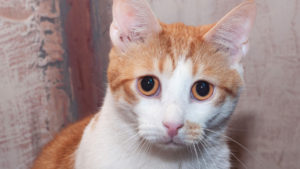
Photo courtesy of Voctiv/Dreamstime
By Dr. Beth Leermakers
Cats are stoic creatures who hide their pain and discomfort. This tendency is adaptive for wild cats that don’t want to reveal weakness to predators. However, domestic cats may suffer if their caregivers don’t realize they’re hurting. Dental disease, arthritis, urinary tract disease, bone disease and cancer are just a few of the common medical conditions that are painful for cats. If your cat has one of these painful conditions, pain management should be an essential component of her treatment.
Look for these eight subtle and not-so-subtle behavioral changes that may indicate your cat is in pain:
Increased or decreased physical activity. When your cat is uncomfortable, she may become less active and sleep more. Stiff, arthritic joints may prevent your cat from jumping onto the counter. Or your cat may be restless, getting up and down repeatedly as if she’s having trouble getting comfortable.
Self-injurious behavior. You may assume your cat is biting or licking himself repeatedly because of allergies. However, he may be doing so because the targeted areas are painful. Cats may develop secondary skin infections or lose their hair as a result of this behavior.
Increased vocalization. Hissing and growling aren’t the only audible signs of an unhappy kitty. Your cat may meow or purr when she’s in pain. Some cats — particularly gentle, easy-going cats — purr when they’re afraid or hurting.
Change in appetite, bathroom habits or unwillingness to snuggle. Loss of appetite may be a sign that your cat is experiencing pain (perhaps from dental disease) or nausea due to a disease process. If your cat stops using the litter box, he may be too sore to reach the box or climb over the high sides. A lap cat who no longer wants to be held may feel pain when he’s touched or petted. Any of these behavioral changes may be due to a medical problem.
Postural changes. Cats may walk gingerly, limp and/or avoid putting weight on a painful limb. A cat experiencing abdominal pain may hunch his back, tucking in his stomach to protect it. Cats may resist being touched in sensitive areas.
Increased aggression. If your normally sweet-natured cat suddenly starts hissing, growling and biting, she may be in pain. Aggression is a cat’s way of asking you to back off and leave her alone.
Unusual facial expressions. A vacant stare or glazed expression can be signs of discomfort. Dilated pupils — part of the stress response — can indicate distress. Panting isn’t normal in cats, so if your cat is panting, particularly when at rest, she needs to see your vet.
Reduced grooming. Cats are usually fastidious creatures, spending hours every day grooming themselves. Pain can make your cat too uncomfortable to maintain her personal hygiene. An arthritic cat may not be able to twist her body to groom those hard-to-reach spots. If your cat stops grooming herself and usually has bad hair days, it’s time for a medical evaluation.
If your cat displays any of these behavioral signs of pain, take him to your vet for an examination. Do NOT give your cat human pain meds, since cats metabolize medications differently than people. Acetaminophen (Tylenol) or ibuprofen (Advil) can be toxic to your cat.
Your vet will evaluate your cat’s medical condition and prescribe appropriate pain medications. You can also make your cat more comfortable by placing her food bowls and litter box in more accessible locations.
